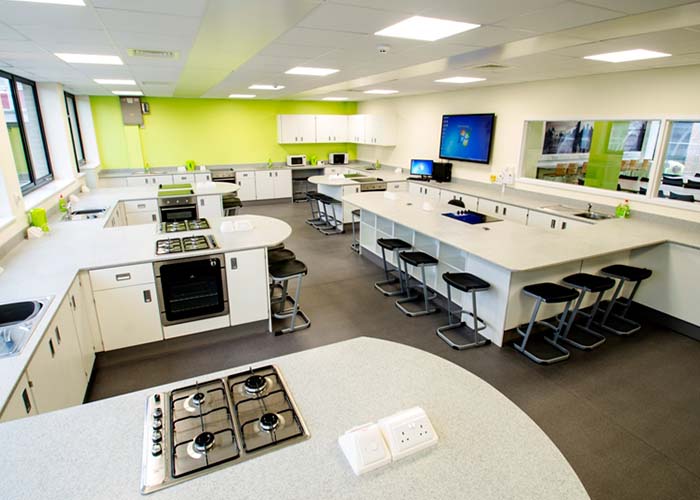Top 10 tips for Food Technology spaces
A well-planned and well-equipped environment for food technology education will benefit both teachers and students and a room that looks as impressive as the way it functions will say a lot about how seriously a school or college regards the facilities it provides for students.
To create a food technology room that really works and also complies with strict health and safety regulations involves careful planning and design. Investing wisely in the installation of cutting-edge facilities, which will withstand the rigours of education and benefit future generation of learners, is therefore vital.
Here are Innova’s top 10 tips for planning the perfect food technology room:
|
ResearchUnderstanding the requirements of the room, in terms of delivering for staff and students and meeting curriculum and health and safety needs, will help to drive the design of the space. Visiting other schools, which have carried out a successful food technology refurbishment will help you to understand what works and may provide inspiration as to what can be achieved. |
BriefA successful design will come from a carefully thought-out brief with all the key requirements clearly stated. That goes from the number of students to the utilities needed and the layout preferences to balance practical and theory work in creating the right learning environment for your school. |
|
LayoutFrom peninsular arrangements to island and perimeter layouts, there are a variety of different solutions to maximise your space and create the best working environment possible. Most common is the peninsular layout, involving a series of bays to provide generous workspace and an option to divide the class into more focused groups for practical work. An island arrangement is ideal for creating an interactive learning environment, while allowing the teacher to move easily between the cooking stations, whereas a perimeter arrangement, with a free central space for tabling, is ideal for schools that want to create a flexible learning space. Sight-lines are another important consideration to allow the teacher to see all cooking areas in accordance with health and safety guidance. |
Health & SafetyHealth and safety regulations must be considered at all stages of the project. As well as clear circulation routes through the classroom, cooking stations require a 500mm working space for safe food preparation and the installation of emergency stop buttons and isolation switches for ovens is mandatory. Consideration must also be given to gas safety systems, adequate drainage and a ventilation system that can handle the need to disperse high rates of water vapour and cooking fumes without excessive noise. Planning and design must also factor in DDA (Disability Discrimination Act) regulations, with features such as rise and fall tables, hobs and sinks enabling disabled students to carry out both theory and practical work. |
|
MaterialsThe provision of solid work surfaces – such as Corian or Velstone – that are resistant to water, heat and impact is critical. Easy-to-wipe surfaces with non-porous properties and seamless capabilities to prevent the harbouring of dirt and food particles are the ideal option. Light colours create a fresh and clean look and invariably provide for a future-proof appearance. |
EquipmentAny successful food technology room has to be well kitted out to allow students to get the most out of their lessons. A teacher’s demonstration bench also adds great educational value. Fridges need to be located at strategic points around the room, while there is usually one cooker and one sink allocated per two students. Stainless steel sinks with double drainers are both cost-effective and practical. |
|
StorageEven more than in most study rooms, storage is a key part of creating a space that works for students and staff in food technology areas. That means places to store equipment from pans to electrical appliances and cooling racks for cooked food. Removable and adjustable shelving is recommended to suit a variety of sizes of equipment and for easy access when deep cleaning. Adequate coat and bag storage is also essential to ensure reduce tripping hazards. |
FurnitureCooking spaces need to be designed to accommodate both practical and theory lessons so furniture – seating and tables – needs to be both flexible and durable. The design must also allow students and teachers to work safely and comfortably, with the comfort of students proven to improve concentration levels and focus in lessons. |
|
SustainabilityRefurbishing a food technology room is a major investment so it’s vital to ensure that the space is easy to maintain and that quality materials are used to increase the life span of furniture, fixtures and fittings. Specifying equipment with the highest energy certification will help a school to minimise the environmental impact of energy use. |
InspirationCooking and food preparation is an increasingly popular and creative subject capable of inspiring future careers. Developing a space which inspires and engages with students learning will reap many rewards. Effective and stimulating design will create a more productive learning space and in turn will produce motivated, confident and inspired learning. |












